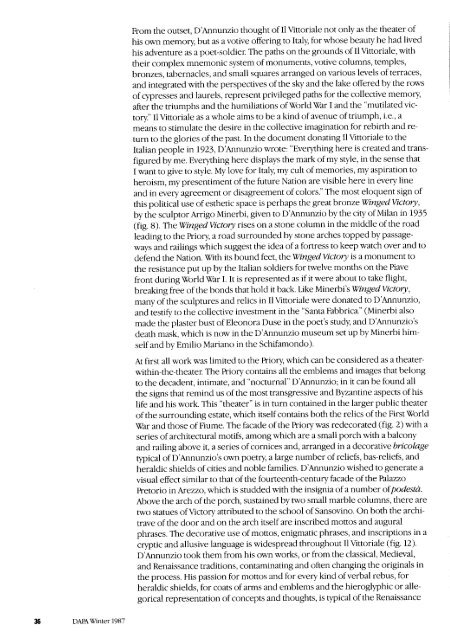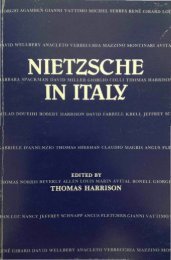The Journal of Decorative and Propaganda Arts - UCLA Department ...
The Journal of Decorative and Propaganda Arts - UCLA Department ...
The Journal of Decorative and Propaganda Arts - UCLA Department ...
Create successful ePaper yourself
Turn your PDF publications into a flip-book with our unique Google optimized e-Paper software.
DAPA\Winter 1987<br />
From the outset, D'Annunzio thought <strong>of</strong> Il Vittoriale not only as the theater <strong>of</strong><br />
his own memory but as a votive <strong>of</strong>fering to Italy, for whose beauty he had lived<br />
his adventure as a poet-soldier. <strong>The</strong> paths on the grounds <strong>of</strong> Il Vittoriale, with<br />
their complex mnemonic system <strong>of</strong> monuments, votive columns, temples,<br />
bronzes, tabernacles, <strong>and</strong> small squares arranged on various levels <strong>of</strong>terraces'<br />
<strong>and</strong> integrated with the perspectives <strong>of</strong> the sk1' <strong>and</strong> the lake <strong>of</strong>fered by the rows<br />
<strong>of</strong> rypresses <strong>and</strong> laurels, represent privileged paths for the collective memory<br />
after the triumphs <strong>and</strong> the humiliations <strong>of</strong> World\Var I <strong>and</strong> the "mutilatedvictory."<br />
Il Vittoriale as a whole aims to be a kind <strong>of</strong> avenue <strong>of</strong> triumph, i.e., a<br />
means to stimulate the desire in the collective imagination for rebirth <strong>and</strong> return<br />
to the glories <strong>of</strong> the past. In the document donating Il Vittoriale to the<br />
Italian people in1923,D'Annunzio wrote: "Every.thing<br />
here is created <strong>and</strong> transfigured<br />
by me. Eveq,thing here displays the mark <strong>of</strong> my style, in the sense that<br />
I want to give to style. My love for Italy, my cult <strong>of</strong> memories, my aspiration to<br />
heroism, my presentiment <strong>of</strong> the future Nation are visible here in every line<br />
<strong>and</strong> in every agreement or disagreement <strong>of</strong> colors." <strong>The</strong> most eloquent sign <strong>of</strong><br />
this political use <strong>of</strong> esthetic space is perhaps the great bronze lVingedVictory,<br />
by the sculptor Arrigo Minerbi, given to D'Annunzio by the city <strong>of</strong> Milan in 1,935<br />
(flg. 8). <strong>The</strong>Wingedvictory rises on a stone column in the middle <strong>of</strong> the road<br />
leading to the Priory a road surrounded by stone arches topped by passageways<br />
<strong>and</strong> railings which suggest the idea <strong>of</strong> a fortress to keep watch over <strong>and</strong> to<br />
defend the Nation. \fith its bound feet, the r{ingedVictory is a monument to<br />
the resistance put up by the Italian soldiers for twelve months on the Piave<br />
front during \rorld Sflar I. It is represented as if it were about to take flight,<br />
breaking free <strong>of</strong> the bonds that hold it back. Like Minerbi'stMingedVictory,<br />
many <strong>of</strong> the sculptures <strong>and</strong> relics in Il Vittoriale were donated to D'Annunzio,<br />
<strong>and</strong> testifi'to the collective investment in the "Santa Fabbrica." (Minerbi also<br />
made the plaster bust <strong>of</strong> Eleonora Duse in the poet's study, <strong>and</strong> D'Annunzio's<br />
death mask, which is now in the D'Annunzio museum set up byMinerbi himself<br />
<strong>and</strong> b1'Emilio Mariano in the Schifamondo).<br />
At first all work was limited to the Priory which can be considered as a theaterwithin-the-theater.<br />
<strong>The</strong> Priory contains all the emblems <strong>and</strong> images that belong<br />
to the decadent, intimate, <strong>and</strong> "nocturnal" D'Annunzio; in it can be found all<br />
the signs that remind us <strong>of</strong> the most transgressive <strong>and</strong> Byzantine aspects <strong>of</strong> his<br />
life <strong>and</strong> his work. This "theater" is in turn contained in the larger public theater<br />
<strong>of</strong> the surrounding estate, which itself contains both the relics <strong>of</strong> the First World<br />
\Var <strong>and</strong> those <strong>of</strong> Fiume. <strong>The</strong> facade <strong>of</strong> the Priory was redecorated (fig. 2) with a<br />
series <strong>of</strong> architectural motifs, among which are a small porch with a balcony<br />
<strong>and</strong> railing above it, a series <strong>of</strong> cornices <strong>and</strong>, arcanged in a decorative bricolage<br />
typical <strong>of</strong> D'Annunzio's own poetry alarge number <strong>of</strong> reliefs, bas-reliefs, <strong>and</strong><br />
heraldic shields <strong>of</strong> cities <strong>and</strong> noble families. D'Annunzio wished to generate a<br />
visual effect similar to that <strong>of</strong> the fourteenth-century facade <strong>of</strong> the hlazzo<br />
Pretorio in Arezzo,which is studded with the insignia <strong>of</strong> a number <strong>of</strong> podestd.<br />
Above the arch <strong>of</strong> the porch, sustained by two small marble columns, there are<br />
two statues <strong>of</strong>Victory attributed to the school <strong>of</strong> Sansovino. On both the architrave<br />
<strong>of</strong> the door <strong>and</strong> on the arch itself are inscribed mottos <strong>and</strong> augural<br />
phrases. <strong>The</strong> decorative use <strong>of</strong> mottos, enigmatic phrases, <strong>and</strong> inscriptions in a<br />
cryptic <strong>and</strong> allusive language is widespread throughout Il Vittoriale (fig. 12).<br />
D'Annunzio took them from his own works, or from the classical, Medieval,<br />
<strong>and</strong> Renaissance traditions, contaminating <strong>and</strong> <strong>of</strong>ten changing the originals in<br />
the process. His passion for mottos <strong>and</strong> for every kind <strong>of</strong> verbal rebus, for<br />
heraldic shields, for coats <strong>of</strong> arms <strong>and</strong> emblems <strong>and</strong> the hierogllphic or allegorical<br />
representation <strong>of</strong> concepts <strong>and</strong> thoughts, is typical <strong>of</strong> the Renaissance




